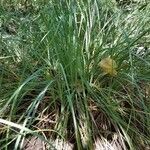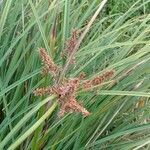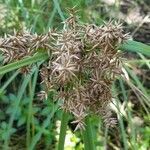Perennial with very short rhizome; stolons wanting. Stems stout, tufted, obtusely trigonous or subterete, smooth, densely papillose, 30-70(-110) cm by up to 4 mm. Leaves canaliculate, rigid, coriaceous, more or less spongy, septate-nodulose, very gradually acuminate, with drooping top, very scabrous on keel and margins by antrorse spinules, glaucous or greyish green, 5-10 mm wide; lower sheaths shining, cinnamomeous to castaneous. Inflorescence large, compound or decompound, up to 15 cm across. Involucral bracts (3-)5-7, widely spreading with drooping top, the lower ones much overtopping the inflorescence, up to 75 cm. Primary rays up to 12, patent, rigid, papillose, up to 10 cm, secondary ones short, divaricate. Spikes broadly cylindrical, obtuse, with up to 50 spikelets, 1½-2 by 1-1½ cm; rachis glabrous, up to 2 cm. Spikelets spicately arranged, at right angles to the rachis or the lower ones reflexed, oblong to lanceolate, hardly compressed, somewhat turgid, falling off as a whole, 6-10(-13)-flowered, 5-9(-13) by 2-2½ mm; rachilla flexuous, broadly winged; wings ovate, yellowish white; internodes ½-1 mm. Glumes subcoriaceous, subpatulous, ovate or broadly ovate, rather acute, hardly keeled. cellular-reticulate, 7-9-nerved, ½-⅔ imbricate, at first pale, afterwards shining brown or purplish-lineolate, with green keel and whitish hyaline margins, 2½-3½ by 2-2½ mm. Stamens 3; anthers oblong-linear, ¾-1¼ ram long. Style 1-1¼ mm; stigmas 3, about as long as the style. Nut trigonous, ellipsoid or subobovoid, apiculate, shining, dark brown to black, 1¼-1½ by ¾-9/10 mm.
More
Perennials. Rhizomes short, thick, woody. Culms scattered, 30-105 cm tall, stout, obtusely 3-angled, papillose, basally with leaves, base swollen. Leaves longer than culm; sheath blackish brown; leaf blade 5-10 mm wide, leathery, base folded, apically gradually flattened, conspicuously transverse veined, midvein and margin spinulose. Involucral bracts 4-6, obliquely spreading, leaflike, much longer than inflorescence. Inflorescence a compound anthela; rays 6-10, obliquely spreading, mostly to 10 cm, papillose, each with 3-7 raylets. Spikes cylindric, 1.5-3 × 0.8-1.2 cm, with many spikelets. Spikelets slightly densely arranged, spreading to downward reflexed, narrowly oblong-ovoid, 4.5-7 × 1.8-2.5 mm, slightly turgid, 4-6-flowered; rachilla broadly winged. Glumes brownish to straw-colored and rusty brown striate, slightly densely imbricate, broadly ovate, ca. 3 mm, subleathery, concave, 7-9-veined, not keeled, margin white hyaline, apex acute and not mucronate. Stamens 3; anthers broadly linear. Style long; stigmas 3. Nutlet blackish brown, broadly ellipsoid to obovoid-ellipsoid, ca. 1/2 as long as subtending glume, 3-sided, with dense punctate processes. Fl. and fr. Jul-Sep.
Characteristic of open, moist to swampy, usually salt or brackish localities near the sea: sandy foreshores, coral reefs, muddy creek-banks, inner border of the mangrove; rarely more inland; 0-250 m. See RIDLEY Disp. 1930 328 .
More
Characteristic of open, moist to swampy, usually salty or brackish localities near the sea: sandy foreshores, coral reefs, muddv creek-banks, inner borders of the mangrove ; rarely more inland ;at elevations up to 250 metres



